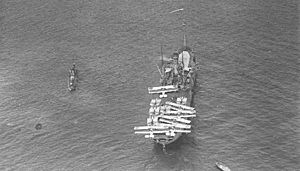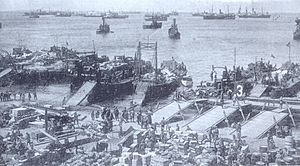Alhucemas landing facts for kids
Quick facts for kids Alhucemas landing |
|||||||
|---|---|---|---|---|---|---|---|
| Part of the Rif War | |||||||
 Desembarco de Alhucemas, José Moreno Carbonero |
|||||||
|
|||||||
| Belligerents | |||||||
| Commanders and leaders | |||||||
| Strength | |||||||
| 13,000 11 tanks 3 battleships 5 light cruisers 1 protected cruiser 1 aircraft carrier 2 destroyers 2 monitors 7 gunboats 18 patrol boats 6 torpedo boats 4 tugs 58 transport ships 160 aircraft |
9,000 | ||||||
| Casualties and losses | |||||||
| 309 killed and wounded | 700 killed | ||||||
The Alhucemas landing was a major military operation that happened on September 8, 1925. It involved Spanish and French forces landing on the coast of Alhucemas in Spanish Morocco. This landing was a key moment in the Rif War, helping to bring it to an end.
This event is special because it was one of the first times tanks and a lot of air support were used in a landing from the sea. Many people see it as an early example of how big landings like those in World War II would be planned. It was also the first successful "combined operation" of the 20th century, meaning different parts of the military (like army, navy, and air force) worked together closely.
About 13,000 Spanish soldiers were brought from cities like Ceuta and Melilla by a large Spanish and French navy. The whole operation was led by General Miguel Primo de Rivera, who was the leader of Spain at the time. General José Sanjurjo was in charge of the troops landing on the beach. Among the officers, a young colonel named Francisco Franco showed great leadership. He was later promoted to general for his actions during this landing.
Contents
Why the Landing Happened
After a big defeat for Spain in 1921, called the Battle of Annual, the Spanish army couldn't take back control of the central Rif region. They tried to stop the rebel area from growing, but it was difficult. People in Spain had different ideas: some wanted to leave Morocco, while others wanted to fight harder.
In 1923, General Primo de Rivera took power in Spain. At first, he thought about pulling Spanish troops back from some areas. But then, in 1925, the Rifian leader, Abd el-Krim, attacked the French-controlled part of Morocco. This was a big mistake for Abd el-Krim.
His attack made Spain and France decide to work together against him. They met in Madrid in June 1925 and planned the Alhucemas landing. This landing was meant to be a strong attack to defeat Abd el-Krim and bring back Spanish control.
Planning the Attack
Alhucemas was very important because it was where Abd el-Krim's tribe lived and was the center of the Rif rebellion. Spain had tried to capture Alhucemas before, but they always failed because their supply lines were too long.
The idea for a landing at Alhucemas had been around since 1913. For this new plan, they first thought about landing 18,000 soldiers, but they ended up landing 13,000. They expected about 11,000 Rifian fighters. This was Spain's first big landing operation in modern times, so it was a big challenge.
The area around Alhucemas Bay was difficult for a landing. Abd el-Krim knew a landing might happen, so he set up artillery and mines along the shore. Because of this, the Spanish leaders had to change their landing spot. They chose Ixdain and Cebadilla Beach, which were west of the main bay.
The main goal was to secure these beaches first. Once they had a strong foothold, they could either expand their control or land more troops in nearby areas. Primo de Rivera and other officers had planned this massive landing since May, even before the meeting with the French. The operation was delayed a few times to make sure everything was ready and to work with the French military.
The Landing Begins
General Primo de Rivera was the overall commander. General José Sanjurjo led the troops on the ground. The main command center was on the Spanish battleship Alfonso XIII. This ship used its radio to coordinate all the army, navy, and air forces.
The Alfonso XIII and another Spanish battleship, Jaime I, along with the French battleship Paris, fired their big guns to support the soldiers landing on the beaches. Many other Spanish and French cruisers also helped. The Spanish fortress on Alhucemas Islands, right in front of the bay, also fired its guns for four hours at the Rifian positions.
A huge number of aircraft, 162 in total, were ready to support the ground troops. These included planes from the Spanish Army and Navy, and French flying boats. The Spanish seaplane carrier Dédalo carried special seaplanes and even an airship. The airship helped guide the artillery fire and supported the troops from above.
First Steps
Abd el-Krim knew the Spanish were planning something because their preparations were very public. He tried to attack Spanish defenses near Tetuan, the capital of the Spanish protectorate. His forces attacked a strong Spanish outpost called Kudia Tahar. This attack forced Primo de Rivera to send some troops back from Alhucemas to help. These troops, supported by planes, pushed back the Rifian forces.
To trick Abd el-Krim about the real landing spot, the Spanish and French ships fired at other parts of the coast. They even pretended to land troops in different areas. This helped keep the Rifian forces guessing.
On the Beach
The landing was supposed to happen on September 7, but bad weather delayed it until the next day. The first troops to land were special forces like the Spanish Legion and local troops loyal to Spain. Most of the soldiers landing were actually local Moroccan troops.
The troops had to wait for hours on crowded landing boats. When they finally landed, the water was too shallow for the boats to reach the shore. So, the soldiers, led by Colonel Francisco Franco, had to wade through the water, holding their rifles above their heads.
The Rifian fighters were surprised by the landing happening so far west, so their reaction was slow. Franco's troops, with heavy support from the ships and planes, moved east. They secured Cebadilla beach, which had mines. Spanish engineers quickly cleared the mines.
Later that day, 11 Renault FT tanks landed on Los Frailes beach, a bit further east. These tanks were then moved to defend the beachhead and the supply area. They were like mobile bunkers, protecting the newly landed troops.
The other main group of soldiers, the Melilla Brigade, landed on September 11. They faced the first Rifian counter-attacks on the heights of Morro Nuevo. Abd el-Krim's special fighters, called juramentados, attacked fiercely. The soldiers ran low on ammunition, but they managed to hold their ground.
Getting water and supplies to the troops was hard because of bad weather and Rifian artillery fire at night. It was also difficult to land mules, which were needed to carry supplies. The Spanish came up with a clever solution: they used floating wooden docks to bring supplies ashore, similar to what would be used in D-Day many years later.
Breaking Out
On September 23, after scouting the area, General Sanjurjo ordered a big attack on the Rifian positions in the mountains. After a huge bombardment from ships and artillery, and air strikes, the Renault FT tanks led the way.
The Spanish troops, including the Legion, attacked Mount Malmusi. On the other side, the Melilla Brigade advanced towards Morro Viejo and Cala del Quemado. In one area, a large mine exploded, but the officers quickly kept the attack going. The Rifian resistance was weak in some places, and the Spanish troops, with the help of tanks, quickly captured Morro Viejo and Cala del Quemado. This cove then became the main place for Spanish supplies.
Later that morning, Colonel Franco's troops attacked the main Rifian positions on Mount Malmusi. They faced strong resistance in a ravine, but the combined attack of the Legion and tanks crushed the Rifian forces. The airship from the Dédalo provided close support from the sky. Mount Malmusi fell to the Spanish by the afternoon. By September 26, the Spanish had secured their positions, and the Rifian artillery stopped firing at the beachhead.
Bad weather and a lack of supplies slowed down the advance until September 30. The next targets were Mount Las Palomas and Mount Buyibar for one group, and Mount Taramara and Mount Taganin for the other. Both groups captured their targets by the afternoon. The tanks helped clear the areas near the rivers.
On October 1, the Melilla Brigade crossed a river into Abd el-Krim's home territory, supported by fire from Alhucemas island. The other brigade marched through the mountains, clearing out the last Rifian strongholds defending Axdir. The capital of the rebel republic fell the very next day.
What Happened Next
The Alhucemas landing was a turning point in the Rif War. It greatly weakened Abd el-Krim's power. Primo de Rivera decided to stop the attacks until the next spring. Some historians questioned this, but his goal was to force Abd el-Krim to negotiate with Spain and France from a weaker position, rather than risking more soldiers.
The Spanish forces lost 24 officers and 132 European soldiers, plus 205 local troops. Many more were wounded.
Axdir, which was the capital of the Rif Republic, was heavily looted by the Spanish and local troops on October 2.
Sources
- Bachoud, André: Los españoles ante las campañas de Marruecos. Madrid, Espasa Calpe, 1988
- Goded, Manuel: Marruecos. Etapas de la pacificación. Madrid, C.I.A.P., 1932
- Hernández Mir, Francisco: Del desastre a la victoria. Madrid, Imprenta Hispánica, 1927
- Larios de Medrano, Justo: España en Marruecos. Historia secreta de la campaña. Madrid, Stampa, 1925
- Martín Tornero, Antonio (1991): El desembarco de Alhucemas. Organización, ejecución y consecuencias. En: Revista de Historia militar, año XXV, nº 70. Madrid, Servicio Histórico Militar. ISSN 0482-5748
- Matthieu, Roger: Mémoires d' Abd-el-Krim. París, Librairie des Champs-Elysées, 1927
- Ros Andreu, Juan Bautista: La conquista de Alhucemas. Novela histórica. Las Palmas, Tipografía La provincia, 1932
- Woolman, David S.: Abd-el-Krim y la guerra del Rif. Barcelona, Oikos-Tau, 1988
- Domínguez Llosá, Santiago: El desembarco de Alhucemas. 2002. ISBN: 978-84-338-2919-1
See also
 In Spanish: Desembarco de Alhucemas para niños
In Spanish: Desembarco de Alhucemas para niños



